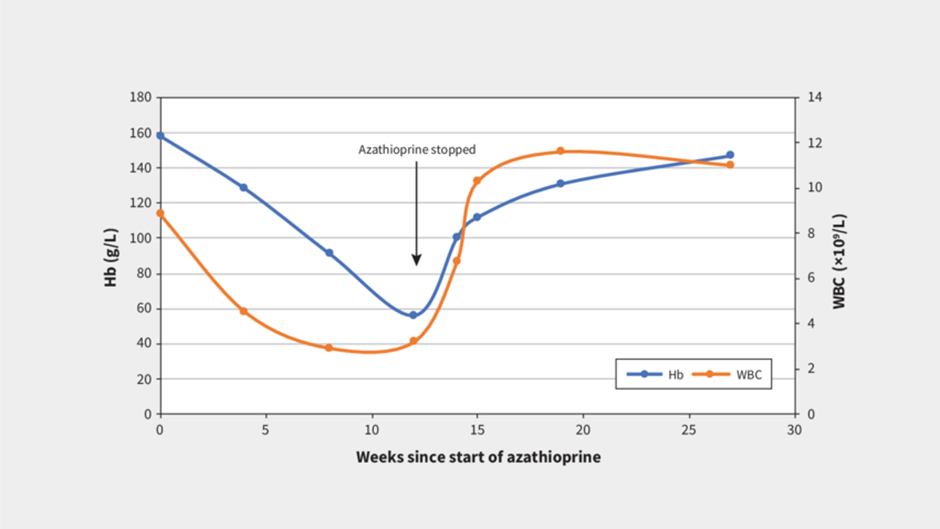A nurse is caring for a client who is taking azathioprine to treat rheumatoid arthritis. Which of the following laboratory values indicates an adverse effect of this medication?
BUN 15 mg/dL
WBC 3,000/mm
Hct 45%
Platelets 250,000/mm
The Correct Answer is B
Choice A Reason:
BUN 15 mg/dL (blood urea nitrogen) is incorrect. An elevated BUN level can indicate kidney dysfunction or dehydration, but it's not typically associated with azathioprine's adverse effects. Azathioprine is known to affect bone marrow, leading to decreased blood cell counts, rather than directly impacting kidney function.
Choice B Reason:
WBC 3,000/mm³ (low white blood cell count) is correct. Azathioprine is an immunosuppressive medication used to treat various conditions, including rheumatoid arthritis. One of its known adverse effects is bone marrow suppression, which can lead to decreased production of blood cells, including white blood cells (WBCs). A low WBC count (leukopenia) can increase the risk of infections due to compromised immune function, making it an important adverse effect to monitor in individuals taking azathioprine.
Choice C Reason:
Hct 45% (hematocrit) is incorrect. A hematocrit of 45% is within the normal range for both men and women. Azathioprine adverse effects usually manifest as blood cell-related issues (such as leukopenia) rather than directly impacting hematocrit levels.
Choice D Reason:
Platelets 250,000/mm³: Platelets within the range of 150,000 to 400,000/mm³ are considered normal. Azathioprine typically affects white blood cells more prominently than platelet counts.

Nursing Test Bank
Naxlex Comprehensive Predictor Exams
Related Questions
Correct Answer is B
Explanation
Choice A Reason:
Weight loss is incorrect. While weight loss can be a side effect of citalopram, it's not typically considered a severe or urgent adverse effect that requires immediate reporting to the provider. It's more often observed in some individuals as a common side effect of this medication.
Choice B Reason:
Confusion can indicate a severe or uncommon adverse reaction to citalopram, especially in the context of treating major depression. It could potentially signify a serious condition that requires immediate attention. Reporting confusion promptly allows the healthcare provider to assess the situation and make appropriate adjustments to the medication regimen or provide additional interventions if necessary.
Choice C Reason:
Insomnia is incorrect. Insomnia is another potential side effect of citalopram. While it can affect the individual's quality of life, it's not typically an adverse effect that would be considered an urgent concern requiring immediate reporting to the provider.
Choice D Reason:
Bruxism is incorrect. Bruxism, or teeth grinding, is a less common side effect of citalopram. While it can cause discomfort or dental issues, it's not typically considered a priority adverse effect that necessitates immediate reporting to the provider compared to confusion, which might indicate a more serious or severe reaction.
Correct Answer is A
Explanation
Choice A Reason:
"I should notify my provider if my stools turn black." This is the appropriate statement. Ferrous gluconate is an iron supplement commonly prescribed to treat or prevent iron deficiency anemia. When taking iron supplements, it's common for stools to become darker or even black in color. This change in stool color is due to the iron and is generally harmless. However, it's essential to inform the healthcare provider about this change because it can also indicate bleeding in the gastrointestinal tract, which requires evaluation.
Choice B Reason:
Taking an antacid with iron supplements can interfere with iron absorption. Antacids may decrease the absorption of iron in the stomach, so it's not recommended to take them together.
Choice C Reason:
While staying upright after taking certain medications can help prevent esophageal irritation or reflux, it's not specifically required with ferrous gluconate.
Choice D Reason:
Taking iron supplements with milk is also not recommended as milk and calcium-containing products can inhibit the absorption of iron. It's generally best to take iron supplements on an empty stomach or with vitamin C to enhance absorption, unless otherwise instructed by the healthcare provider.
Whether you are a student looking to ace your exams or a practicing nurse seeking to enhance your expertise , our nursing education contents will empower you with the confidence and competence to make a difference in the lives of patients and become a respected leader in the healthcare field.
Visit Naxlex, invest in your future and unlock endless possibilities with our unparalleled nursing education contents today
Report Wrong Answer on the Current Question
Do you disagree with the answer? If yes, what is your expected answer? Explain.
Kindly be descriptive with the issue you are facing.
